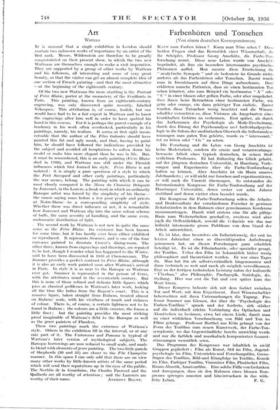Art
Watteau
IT is unusual that a single exhibition in London should contain two unknown works of importance by an artist of the
first rank. Messrs. Wildenstein are therefore to be greatly congratulated on their present show, in which the two new Wattcaus are themselves enough to make a visit imperative.
They are supported by a group of other works by Watteau and his followers, all interesting and some of very great beauty, so that the visitor can get an almost complete idea of . one section of French painting—and that the most attractive —at the beginning of the eighteenth century.
Of the two new Watteaus the more startling is the Portrait of Frere Blaise, porter at the monastery of the Feuillants in
Paris. This painting, known from an eighteenth-century engraving, was only discovered quite recently, labelled • Velasquez. This attribution is, of course, foolish, but one would have had to be a fair expert in Watteau and to know the engravings after him well in order to have spotted his hand in this canvas. For it is perhaps the purest example of a
• tendency in his work often overlooked, particularly in his paintings, namely, his realism. It seems at first• sight incon- ceivable that the author of the Files Galantes should have painted this fat and ugly monk, and that, having to paint him, he should have followed the indications provided by the subject and avoided all temptations to soften down his model or make him more elegant than he was in life. But, it must be remembered, this is an early painting (Frere Blaise died in 1709), and Watteau was still under the Flemish influences which first formed his style. Frere Blaise is not isolated ; it is simply a pure specimen of a style to which the Petit Savoyard and other early paintings, particularly the war scenes, belong. The painting with which it can be most closely compared is the Messe du Chanoiue Delaporte by Jouvenet, in the Louvre, a freak work in which an ordinarily Baroque artist was forced by the simplicity of his theme—
• the canon saying mass before a few poor people and priests at Notre-Dame—to a corresponding simplicity of style. Whether there was direct influence or not, it is remarkable how Jouvenet and Watteau slip into the same colour scheme of buffs, the same severity of handling, and the same even, undramatic distribution of light.
The second work by Watteau is not new in quite the same sense as the Frere Blaise. Its existence has been known for some time,' but it-has hardly ever been either exhibited or reproduced. It represents Summer, and is one of the four canvases painted to decorate Crozat's dining-room. The other three, known from engravings and drawings, are reputed to be lost, though I wonder what has happened to the Winter, -said to have been discovered in 1858 at Chenoneeaux. The Summer provides a perfect contrast to Frere Blaine, although it is also an early work painted soon after Watteau's arrival in Paris. In style it is as near to the Baroque as Watteau ever got. Summer is represented in the person of Ceres, with the attributes usual in the seventeenth century. But this is none of those refined and delicate little figures which pass as classical goddesses in Watteau's later work, looking all the time like ladies from the Regent's court. This is a massive figure, taken straight from Rubens, treated almost on Rubens' scale, with his vividness of touch and richness of colour. There is, of course, a certain lightness not to be found in Rubens ; the colours are a little sweeter, the forms a little finer ; but the painting provides the most striking proof imaginable of Watteau's debt to the Baroque as well as the genre painters of Flanders.
These two paintings mark the extremes of Watteau's style. Others in the exhibition fill in the interval, or at any rate part of it. The Vertumnus and Pomona is typical of
Watteau's later version of mythological subjects: The Baroque borrowings are now reduced to small scale, and made
to blend with elements of genre painting. The two little panels of Shepherds (30 and 31) are closer to the Fite Champitre manner. In this space I can only add that there are on view
many other works by little-known artists of the same period which will send their reputations up in the eyes of the public. The Norblin de in Gourdaine, the Charles Parroeel and the Quillards are all worthy of attention ; and the Lancrets are




















































 Previous page
Previous page